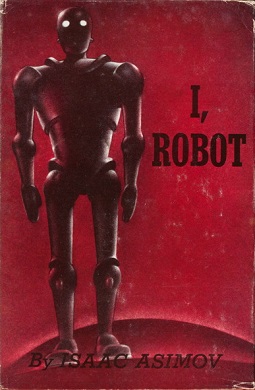
I, Robot is a fixup collection made up of science fiction short stories by American writer Isaac Asimov. The stories originally appeared in the American magazines Super Science Stories and Astounding Science Fiction between 1940 and 1950 and were then collected into a 1950 publication Gnome Press in 1950, in an initial edition of 5,000 copies.

Isaac Asimov was an American writer and professor of biochemistry at Boston University. During his lifetime, Asimov was considered one of the "Big Three" science fiction writers, along with Robert A. Heinlein and Arthur C. Clarke. A prolific writer, he wrote or edited more than 500 books. He also wrote an estimated 90,000 letters and postcards. Best known for his hard science fiction, Asimov also wrote mysteries and fantasy, as well as popular science and other non-fiction.
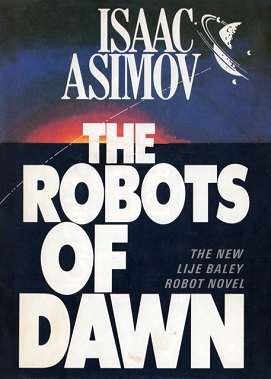
The Robot Series is a series of thirty-seven science fiction short stories and six novels created by American writer Isaac Asimov, published from 1940 to 1995. The series is set in a world where sentient positronic robots serve a number of purposes in society. To ensure their loyalty, the Three Laws of Robotics are programmed into these robots, with the intent of preventing them from ever becoming a danger to humanity. Later, Asimov would merge the Robot series with his Foundation series.
The Galactic Empire series is a science fiction sequence of three of Isaac Asimov's earliest novels, and extended by one short story. They are connected by their early place in his published works and chronological placement within his overarching Foundation universe, set around the rise of Asimov's Galactic Empire, between the Robot and Foundation series to which they were linked in Asimov's later novels.

The Three Laws of Robotics are a set of rules devised by science fiction author Isaac Asimov, which were to be followed by robots in several of his stories. The rules were introduced in his 1942 short story "Runaround", although similar restrictions had been implied in earlier stories.
Edward Groff Conklin was an American science fiction anthologist. He edited 40 anthologies of science fiction, one of mystery stories, wrote books on home improvement and was a freelance writer on scientific subjects as well as a published poet. From 1950 to 1955, he was the book critic for Galaxy Science Fiction.
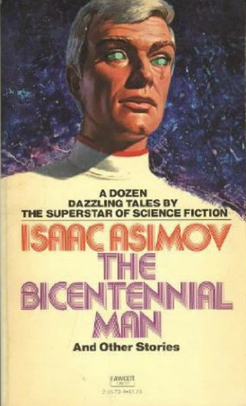
The Bicentennial Man is a novelette in the Robot series by American writer Isaac Asimov. According to the foreword in Robot Visions, Asimov was approached to write a story, along with a number of other authors who would do the same, for a science fiction collection to be published in honor of the United States Bicentennial. However, the arrangement fell through, leaving Asimov's the only story actually completed for the project. Asimov sold the story to Judy-Lynn del Rey, who made some small changes to the text. Asimov restored the original text when the story was collected in The Bicentennial Man and Other Stories (1976).
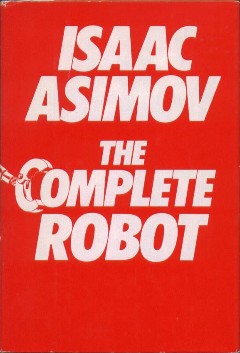
The Complete Robot (1982) is a collection of 31 of the 37 science fiction short stories about robots by American writer Isaac Asimov, written between 1939 and 1977. Most of the stories had been previously collected in the books I, Robot and The Rest of the Robots, while four had previously been uncollected and the rest had been scattered across five other anthologies. They share a theme of the interaction of humans, robots and morality, and put together tell a larger story of Asimov's fictional history of robotics. The stories are grouped into categories.
"Blind Alley" is a science fiction short story by American writer Isaac Asimov. It was first published in the March 1945 issue of Astounding Science Fiction, and later included in the collection The Early Asimov (1972).

"I, Robot" is a science fiction short story by Eando Binder, part of a series about a robot named Adam Link. It was published in the January 1939 issue of Amazing Stories.
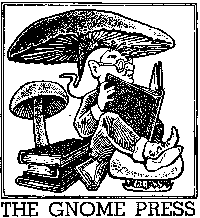
Gnome Press was an American small-press publishing company primarily known for publishing many science fiction classics. Gnome was one of the most eminent of the fan publishers of SF, producing 86 titles in its lifespan — many considered classic works of SF and Fantasy today. Gnome was important in the transitional period between Genre SF as a magazine phenomenon and its arrival in mass-market book publishing, but proved too underfunded to make the leap from fan-based publishing to the professional level. The company existed for just over a decade, ultimately failing due to inability to compete with major publishers who also started to publish science fiction. In its heyday, Gnome published many of the major SF authors, and in some cases, as with Robert E. Howard's Conan series and Isaac Asimov's Foundation series, was responsible for the manner in which their stories were collected into book form.

Miles John Breuer was an American physician and science fiction writer of Czech origin. Although he had published elsewhere since the early 20th century, he is considered the part of the first generation of writers to appear regularly in the pulp science fiction magazines, publishing his first story, "The Man with the Strange Head", in the January 1927 issue of Amazing Stories. His best known works are "The Gostak and the Doshes" (1930) and two stories written jointly with Jack Williamson, "The Girl from Mars" (1929) and The Birth of a New Republic (1931).
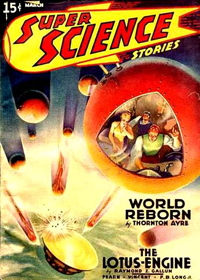
Super Science Stories was an American pulp science fiction magazine published by Popular Publications from 1940 to 1943, and again from 1949 to 1951. Popular launched it under their Fictioneers imprint, which they used for magazines, paying writers less than one cent per word. Frederik Pohl was hired in late 1939, at 19 years old, to edit the magazine; he also edited Astonishing Stories, a companion science fiction publication. Pohl left in mid-1941 and Super Science Stories was given to Alden H. Norton to edit; a few months later Norton rehired Pohl as an assistant. Popular gave Pohl a very low budget, so most manuscripts submitted to Super Science Stories had already been rejected by the higher-paying magazines. This made it difficult to acquire good fiction, but Pohl was able to acquire stories for the early issues from the Futurians, a group of young science fiction fans and aspiring writers.
"Deadline" is a 1944 science fiction short story by American writer Cleve Cartmill, first published in Astounding Science Fiction. The story described the then-secret atomic bomb in some detail. At that time the bomb was still under development and top secret, which prompted a visit by the FBI.

Giants Unleashed is an anthology of science fiction short stories edited by Groff Conklin. It was first published in hardcover by Grosset & Dunlap in 1965. A paperback edition followed from the publisher's Tempo Books imprint in April 1966. It was reprinted, minus the introduction and under the alternate title Minds Unleashed, in October 1970.

Six Great Short Science Fiction Novels is an anthology of science fiction short stories edited by Groff Conklin. It was first published in paperback by Dell in November 1960. The book should not be confused with his similarly titled earlier anthology, 6 Great Short Novels of Science Fiction.
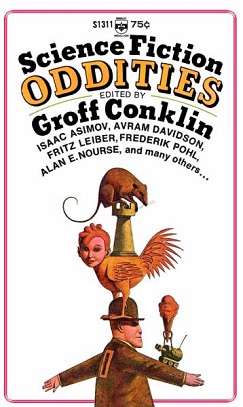
Science Fiction Oddities is an anthology of science fiction short stories edited by Groff Conklin. It was first published in paperback by Berkley Medallion in November 1966. It was split into two volumes for its first British edition, issued in hardcover by Rapp & Whiting as Science Fiction Oddities and Science Fiction Oddities: Second Series in June 1969.

17 X Infinity is an American anthology of science fiction short stories edited by Groff Conklin. It was first published in paperback by Dell in August 1963 and reprinted in April 1969. The first British edition was issued by Mayflower-Dell in 1964 and reprinted in 1965.
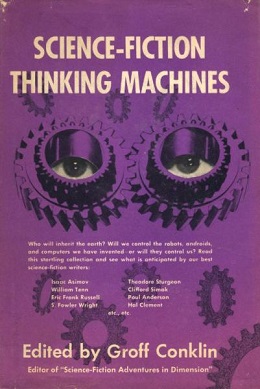
Science Fiction Thinking Machines: Robots, Androids, Computers is an anthology of science fiction short stories edited by American anthologist Groff Conklin. It was first published in hardcover by Vanguard Press in May 1954. An abridged paperback edition titled Selections from Science Fiction Thinking Machines was published by Bantam Books in August 1955 and reprinted in September 1964.

Operation Future is an anthology of science fiction short stories edited by Groff Conklin. It was first published in paperback by Permabooks in July 1955 and reprinted in September 1956.















